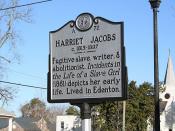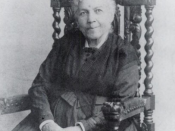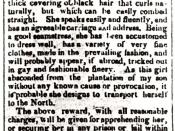In order for one to truly understand the essence and view for an autobiographical narrative, the author must be extremely personal and honest regardless of their relationship with the public. As a slave girl, Harriet Jacobs found this task very difficult. She had to contend with an audience that offered no support or compassion for women in her position." I had no motive for secrecy on my own account."(1) This motivation sparked controversy among the whites and admiration with the few that understood the necessity for absolute truth.
Harriet's early slave life was relatively sheltered considering the situation. Until her death in 1825, her somewhat kind mistress, Margaret Horniblow, taught the young slave to read and sew. These important tools were the catalyst on her mission to freedom.
After the death of her mistress, Harriet was bequeathed to the niece of the mistress. James and Maria Norcom were her new masters.
This is when she was shown the brutal realities of slavery.
In her novel, she renames the characters including her, to protect herself from readers whose comprehension she could not take for granted. Dr. Norcom was renamed "Dr. Flint" and Harriet called herself, "Linda Brent."
Dr. Flint was shrewd and firm and showed no respect for Harriet's mental and physical well-being. Not only was he physically abusive, he was mentally abusive. When Harriet fell in love to a free black man, she was ostracized and abused for showing her love towards the man. After confronting Harriet about her love, Dr. Flint exclaimed, " I supposed you thought more of yourself; that you felt above the insults of such puppies."(39) Dr. Flint was taking over the most vital and personal part of her life. Harriet realized that slavery had taken over her god given right to love. Dr. Flint was...


